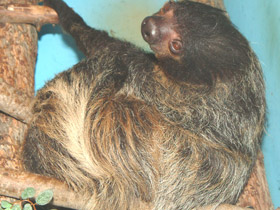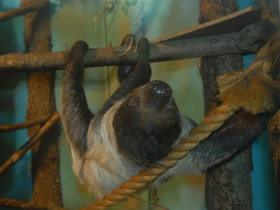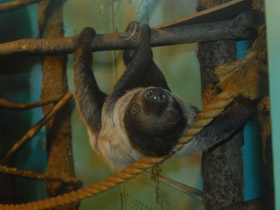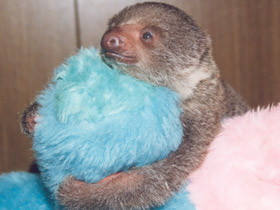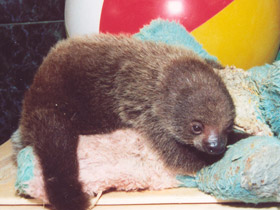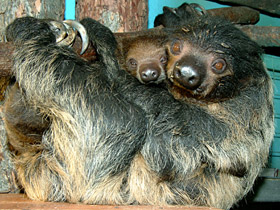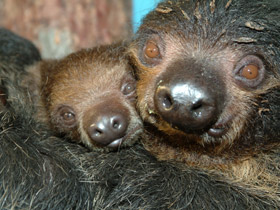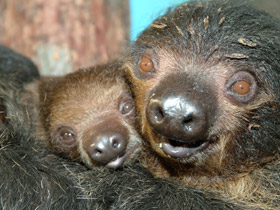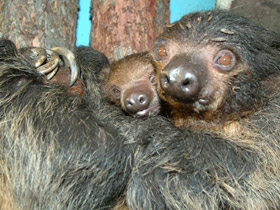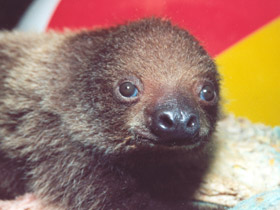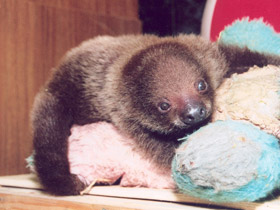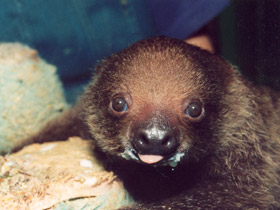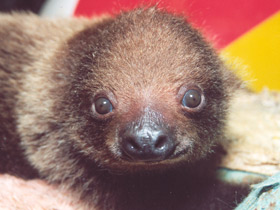Family of Sloths Bradypodidae
Sloths are unique mammals that do not resemble any other extant animals. Sloths are small animals (weights range between 4 and 9 kg) that have very long, powerful limbs, short tails, tiny eyes, and round heads with inconspicuous eyes. Sloths are found in tropical rainforests and spend their lives hanging upside-down from the trees.
Their limbs equipped with long, strong claws are perfectly adapted to this lifestyle. Sure, all sloths are built for life in the treetops. Long outer hairs are angled “up” in the opposite direction to other mammals so that the hair hangs down when the sloth is hanging in its inverted position, which prevents the hair from getting wet under tropical rains because drops of water roll down over the dense, course fur of the animal. The fur may be tinged green by algae growing on the sloth hair, which provides a perfect camouflage, making the sloth blend in the foliage. Sloths are able to spend their lives hanging in trees and not experiencing any problems with breathing because their abdominal organs are held by bands of fibrous tissue that keep them from sliding around too much and pressing into the chest cavity. Another specific feature of the sloth is its significantly enlarged or reduced inner organs. For instance, stomach is very large, weighing 30 percent of the total body weight and its structure is similar to that of the ruminant stomach. It is not surprising as sloths are classified as folivores. Their digestion process is very slow and eaten food may stay in the stomach for up to 100 hours. Due to the structure of their stomach and intestine, sloths typically defecate once in 8 to 10 days (and in some cases, even once a month!). In order to defecate, the sloth has to come down to the ground and then climb back on the tree. Since sloths move extremely slowly, this process sometimes takes the animal the whole day. All processes in sloth’s body are slowed down and it doesn’t only refer to digestion: the respiratory rate in the sloth is only 6 or 7 breaths per minute. When the ambient temperature drops, sloths go into the state of torpor and their basal temperature decreases to 200C. Sloths have other unusual features; for instance, different species may have 6 to 9 cervical vertebrae (while other mammals have 7). At the same time, extra neck vertebrae allow sloths to turn their heads 270 degrees. Sloth females give birth to fully developed, furred offspring which have their eyes open. Young sloth clings to its mother’s fur with its hook-shaped claws and the mother carries it for a few months. The young is not weaned until it is 2 to 3 months old, after which it starts feeding on leaves. Sloths become sexually matured by the age of nine months.
This family includes only two genera, three toed sloth comprising three species, and two-toed sloth consisting of 2 species. All sloths are found in South America and although they are primitive and slow, these strange mammals are most common inhabitants of tropical rainforests.
Linnaeus's two-toed sloth Choloepus didactylus

















